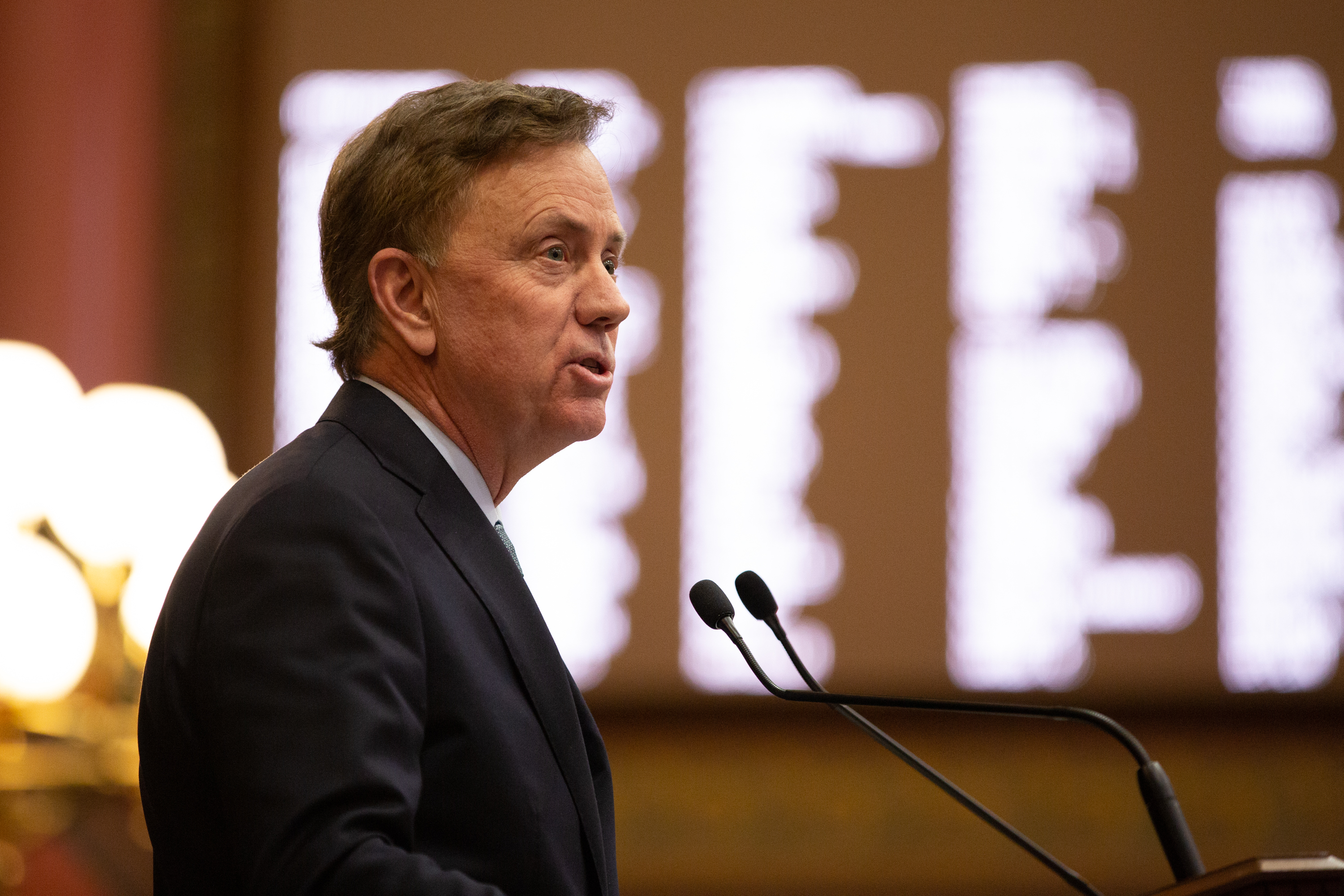Lamont Hopes Cap Will Keep Lawmakers’ Hands off $2.5B Reserve

Audio By Carbonatix

Gov. Ned Lamont giving his first budget address to the legislature one year ago. Wednesday, he will outline his spending priorities for the coming year. Photo credit: Ryan Caron King, CT Public Radio (Courtesy of CTMirror.org)
Connecticut is sitting on a multi-billion-dollar reserve but lawmakers will have to get around the spending cap – and the governor – if they want to tap it.
By Keith M. Phaneuf, CTMirror.org
The new state budget proposed Wednesday by Gov. Ned Lamont will likely spur considerable debate – despite lacking major tax hikes or deep spending cuts.
That’s because for the first time in history, Connecticut is sitting on a multi-billion-dollar reserve, and a tight spending cap that can’t be pried open by lawmakers.
That is, unless Lamont is willing to employ the gimmicks or declarations of fiscal emergency that his predecessors have used to circumvent the cap.
That appears unlikely.
“The budget Governor Lamont will present to the General Assembly Wednesday is fully compliant with all of the existing caps and does not engage in the game-playing and gimmickry that have haunted our state for decades,” Chris McClure, spokesman for Lamont’s budget office, said last week. “His budget proposal is honestly balanced and reflects his continued effort to be a prudent and responsible steward of our state’s resources.”
Since he took office in January 2019, Lamont has insisted Connecticut rebuild its rainy day fund, the chief defense against the next recession. This is more vital here than in other states, Lamont and others contend, since Connecticut’s income tax receipts – nearly one-third of which come with investment-related earnings – historically have been highly volatile.
“The steps we have taken to stabilize our pensions, reduce our borrowing, decrease our reliance on volatile revenues, and help build the largest rainy day fund in history have been noticed on Wall Street,” McClure said, adding that Connecticut’s standing with credit rating agencies has improved over the past 13 months.
But the state’s reputation on Wall Street isn’t the only thing that’s changed.
Many, including some of Lamont’s fellow Democrats in the legislature, insist that social services, municipal aid, higher education, transportation and other priorities have taken the brunt of the state’s budget woes over the past decade as a sluggish recovery and surging pension and other debt costs have drained resources.
And critics who want to restore funding for these priorities have a hard time hearing “no” when Connecticut has $2.5 billion in the bank – and nearly $300 million more set to be deposited after next summer.
“This is not the conversation we should be having,” Sen. Saud Anwar, D-South Windsor, said last week, referring to a Lamont agenda that, so far, hasn’t included more resources for community-based nonprofits that treat the disabled, abused, poor and patients struggling with addiction. “But misery doesn’t sell. Sadness doesn’t sell.”
Anwar stood with nonprofit leaders last week to ask Lamont to gradually increase state funding for the hundreds of nonprofits who deliver the bulk of Connecticut’s social services. The nonprofits are seeking an average increase of $92 million more in funding each year for the next five years to mitigate nearly two decades of state support that failed to match inflation.
At first glance, the math works, even without touching the $2.5 billion in the reserve.
Nonpartisan analysts project Connecticut will add $300 million to its reserves next September through a program that forces the state to save a portion of its income tax receipts tied to investment earnings.
It would appear easy to carve $92 million out of that windfall to give to the nonprofits next fiscal year.
But it’s not that simple.
The preliminary $22.1 billion budget Lamont and the legislature approved last May for the 2020-21 fiscal year can be amended. Lamont’s plan, due Wednesday when the 2020 legislative session begins, essentially involves his proposed adjustments.
But that plan falls just $5 million under the state spending cap. That’s a razor-thin 1/40th of 1% of that budget’s General Fund.
So if lawmakers want to give $92 million to the nonprofits, Lamont expects them to propose about $92 million in matching cuts. Whatever spending you add in one place, you take off somewhere else.
And that’s not the only spending proposal.
Senate Democrats called two weeks ago for Connecticut to replenish federal funds that Planned Parenthood clinics have lost for refusing to follow a Trump administration gag rule.
Senate Majority Leader Bob Duff, D-Norwalk, wasn’t dismayed about the spending cap and insisted the $2 million proposed for Planned Parenthood would be approved.
“We wouldn’t announce this today if it wasn’t something we were serious about,” he said.
Democratic and Republican lawmakers also have talked about restoring funds for those nursing homes targeted to lose state aid due to large numbers of vacant beds.
Legislators typically propose tens of millions of dollars in additional spending during the second year of a biennial budget cycle, and more requests are expected to come forth after the session opens Wednesday.
To mitigate these spending impulses, Connecticut has long had a cap.
First enacted in 1991 to mollify voter outrage over the state income tax, the cap was designed to keep spending growth largely in line with the growth in personal income.
One year later, voters overwhelmingly ratified an amendment to the Connecticut Constitution stipulating in that document there shall be a cap. But legislatures never implemented that provision, instead continuing to follow the statutory cap – sort of.
The problem, for budget purists, is that there were plenty of ways around this cap.
For one, the governor and legislature could legally exceed it with a 60% vote of approval by the House and Senate. Republican Govs. John G. Rowland and M. Jodi Rell did this frequently during the 1990s and 2000s. But their administrations included many years of a robust national economy that help keep state tax hikes to a minimum.
Rowland, Rell and the Democratic legislatures they worked with also routinely short-changed pension contributions, which helped to keep taxes down and public attention away from the cap – while shifting debt costs, plus interest, onto future generations.
Democrat Dannel P.Malloy, who became governor in January 2011 and twice ordered major tax hikes, refused to legally exceed the cap during his eight years in office.
But Malloy, who paid far more into the pensions than his predecessors did, found other ways to get around the cap.
For example, rather than pay money directly to charter schools, Malloy funneled tens of millions of dollars to the communities where the schools were located – and instructed those municipalities to then forward the funds to the charter schools. Why the extra step? Because many charter schools are located in poor cities, and aid to distressed municipalities was exempt from the cap.
Malloy and lawmakers also moved hundreds of millions of dollars in federal funding for health care outside of the budget, thereby clearing space under the cap.
Perhaps the previous governors’ most common route around the spending cap was via the state’s credit card. Borrowed dollars are spent outside of the budget – and therefore don’t impact the cap. And while payments on bonded debt are within the budget, they are cap-exempt.
Connecticut pays cash for most aid to cities and towns, but under Malloy municipal grants funded with borrowed dollars rose from $30 million per year to $150 million.
By 2017, Connecticut was borrowing about $150 million per year to make payments on borrowing.
Lamont pledged not to add to Connecticut’s history of spending cap gimmicks.
And even if there were more room under the cap next fiscal year, Lamont says Connecticut needs to preserve that rainy day fund to guard against the next economic slip.
“Remember, the rainy day fund is to make darn sure that when there’s a rainy day I don’t have to cut funding for services like this at a time of most need,” Lamont said last November after addressing nonprofit social service agencies at their annual convention.
And Lamont has some allies across the aisle to help him defend the spending cap.
Minority Republicans in the House and Senate both say they aren’t interested in voting to exceed the spending cap.
Democrats currently hold 90 out of 151 seats in the House and 22 out of 36 in the Senate, almost matching the precise numbers needed – 91 and 22 – to achieve the 60% vote needed to legally exceed the cap.
Even in the Senate, where Democrats already hold 60% of the seats, the odds of all party moderates going along with a cap override are slim, meaning GOP cooperation would be needed in both chambers.
Republican leaders say there’s no chance of that.
When Democrats and Republicans in the legislature ended 10 months of budget gridlock and approved a bipartisan plan in October 2017, the GOP insisted on a tighter cap. The exemption for aid to poor communities is gone.
Republicans also joined moderate Democrats in pushing hard for the new requirement to save a portion of income tax receipts tied to investment earnings.
“The various capping structures that were put into place [in 2017] have created a new approach to budgeting in the state of Connecticut,” said Deputy House Majority Leader Vincent J. Candelora, R-North Branford. “I’m worried the Democrats are going to try to go back, to put some bad fiscal policies into place, and that’s something we’re going to fight.”
“I think we’re going to have to guard against one attempted end-run after another,” said Senate Minority Leader Len Fasano, R-North Haven. “We’ve finally got some money in the rainy day fund. We finally have a cap that can help control our expenses. I’m not about to go back on those.”
But most Democratic legislators say the GOP leaders’ comments are little more than posturing. While Republicans criticized the two-year budget adopted last May – which featured more than $300 million in tax hikes each year but closed major projected deficits – the GOP didn’t even offer its own budget proposal.
Regardless of the partisan sparring, the Lamont administration says the cap is budget reality, and legislators must deal with it.
“Governor Lamont will not back down from his budgeting approach, viewing this through a longer less and not simply an annual or biennial, short-term exercise,” McClure said. “The administration is focused on putting Connecticut in the best possible position for the next decade through sound financial management.”
Reprinted with permission of The Connecticut Mirror. The author can be reached at [email protected] .
Like what you see here? Click here to subscribe to We-Ha’s newsletter so you’ll always be in the know about what’s happening in West Hartford!



